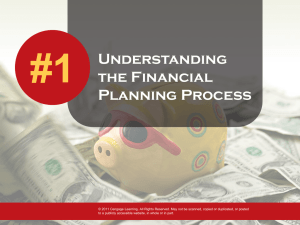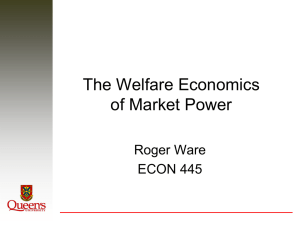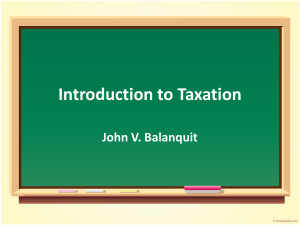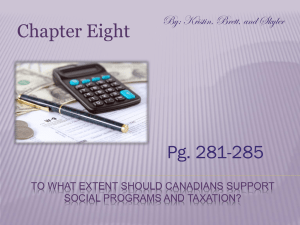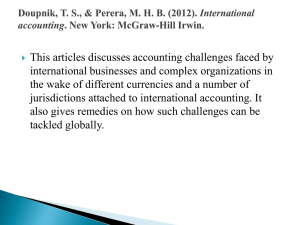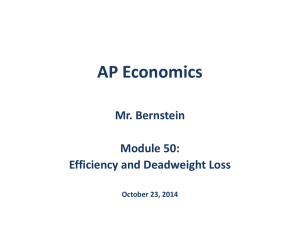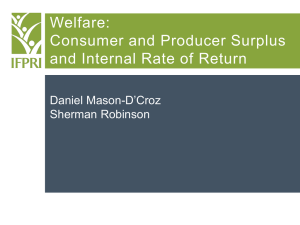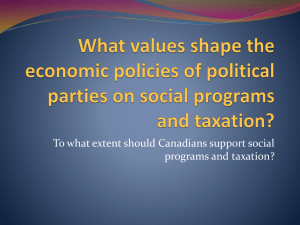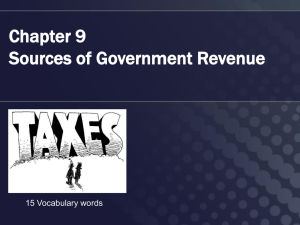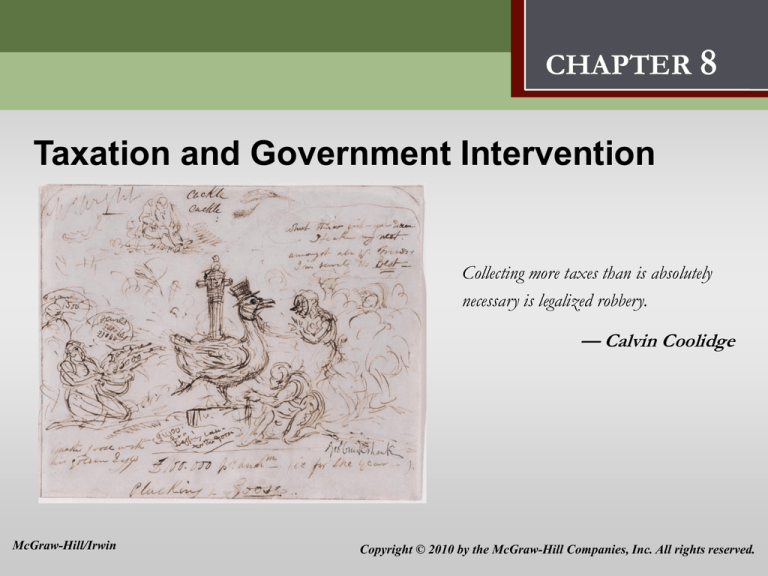
Taxation and
Government Intervention
8
CHAPTER 8
Taxation and Government Intervention
Collecting more taxes than is absolutely
necessary is legalized robbery.
— Calvin Coolidge
McGraw-Hill/Irwin
Copyright © 2010 by the McGraw-Hill Companies, Inc. All rights reserved.
Taxation and
Government Intervention
8
Chapter Goals
• Show how equilibrium maximizes consumer and producer
surplus
• Demonstrate the burden of taxation to consumers and
producers
• Explain why the person who physically pays the tax is not
necessarily the person who bears the burden of the tax
• Demonstrate how an effective price ceiling is the equivalent
of a tax on producers and a subsidy to consumers
• Define rent seeking and show how it is related to elasticity
• State the general rule of political economy
8-2
Taxation and
Government Intervention
8
Producer and Consumer Surplus
• Consumer surplus is the value the consumer gets from
buying a product, less its price
• It is the area below the demand curve and above
the price
• Producer surplus is the value the producer sells a
product for less the cost of producing it
• It is the area above the supply curve but below the
price the producer receives
8-3
Taxation and
Government Intervention
8
Producer and Consumer Surplus
P
$10
9
8
7
6
5
4
3
2
1
Consumer surplus =
area of red triangle =
½($5)(5) = $12.5
S
Producer surplus =
area of green triangle =
½($5)(5) = $12.5
CS
PS
D
0 1 2 3 4 5 6 7 8
Q
The combination of
producer and consumer
surplus is maximized at
market equilibrium
8-4
Taxation and
Government Intervention
8
Producer and Consumer Surplus
Suppose P=$6
P
$10
9
8
7
6
5
4
3
2
1
Consumer surplus decreases =
area of red triangle =
½($4)(4) = $8
Lost surplus
(deadweight loss)
= ½($2)(1) S
Producer surplus increases =
areas of green triangle and
rectangle =
½($6)(4)+($2)(4)= $20
CS
PS
D
0 1 2 3 4 5 6 7 8
Q
The combination of producer
and consumer surplus
decreases when price is
greater than equilibrium price
8-5
Taxation and
Government Intervention
8
The Burden of Taxation
P
S
If there is no tax, market
equilibrium is reached and
consumer and producer
surplus is maximized
P
D
Q
Q
8-6
Taxation and
Government Intervention
8
The Burden of Taxation
P
A tax paid by the supplier
shifts the supply curve up by
the amount of the tax (=t)
S1
S0
Both producer and
consumer surplus decrease
Positive government revenue
t
P1
P0
P1-t
D
Deadweight loss exists
Q1
Q0
Q
8-7
Taxation and
Government Intervention
8
The Burden of Taxation
The costs of taxation include:
• Direct cost of the tax paid to the government by
consumers and producers
• The deadweight loss which is the loss of consumer
and producer surplus that is not gained by the
government
• The administrative costs of compliance which
are the resources used by the government to
administer the tax and individuals and businesses to
comply with it
8-8
Taxation and
Government Intervention
8
The Burden of Taxation
The tax burden:
• The person who physically pays the tax is not
necessarily the person who bears the burden of
the tax
• The more inelastic one’s relative demand and supply,
the larger the tax burden one will bear
• If demand is more inelastic than supply,
consumers will pay the higher share
• If supply is more inelastic than demand,
suppliers will pay the higher share
8-9
Taxation and
Government Intervention
8
What Goods Should Be Taxed?
Goal of Government
Most effective when
Raise revenue, limit deadweight loss
Demand or supply is inelastic
Change behavior
Demand or supply is elastic
Elasticity
Who bears the burden?
Demand inelastic and supply elastic
Consumers
Supply inelastic and demand elastic
Producers
Both supply and demand elastic
Shared, but the group whose S or D is
more inelastic pays more
8-10
8
Taxation and
Government Intervention
The Burden of Taxation
Demand is relatively elastic
Demand is relatively inelastic
P
P
S1
Producers
pay more
t
Consumers
pay more
S1
S0
t
P1
P1
S0
P0
P0
P1-t
P1-t
D
Q1
Q0
Q
D
Q1 Q0
Q
8-11
Taxation and
Government Intervention
8
The Burden of Taxation
How to calculate the fraction of the tax borne by
consumers and producers:
Fraction of tax borne
by demander
Fraction of tax borne
by supplier
ES
ED ES
ED
ED ES
8-12
Taxation and
Government Intervention
8
The Burden of Taxation
The tax burden is independent of who pays the tax
P
P
Supplier pays the tax,
supply shifts
Consumer pays the tax,
demand shifts
S1
t
S0
S
P1
P1+t
P0
P0
P1-t
P1
D
Q0
Q1
Q
t
D0
D1
Q0
Q1
Q
8-13
Taxation and
Government Intervention
8
Tax Incidence and Current Policy Debates
Social Security Taxes
• Both employer and employee contribute the same
percentage of before-tax wages to the Social Security
fund
• Although the employer and employee contribute the
same percentage, they do not share the burden equally
• On average, labor supply tends to be less elastic than
labor demand, so the Social Security tax burden is
primarily on employees
8-14
Taxation and
Government Intervention
8
Tax Incidence and Current Policy Debates
Sales Taxes
• Sales taxes are paid by retailers on the basis of their
sales revenue
• Since sales taxes are broadly defined to include most
goods and services, consumers find it hard to substitute
to avoid the tax
• Demand is inelastic so consumers bear the greater
burden of the tax
• As consumers increase purchases on the Internet where
sales are not taxed, retail stores will bear a greater
burden of the sales tax
8-15
Taxation and
Government Intervention
8
Government Intervention as Implicit Taxation
• Government intervention in the form of price controls can
be viewed as a combination tax and subsidy
• An effective price ceiling is a government set price below
the market equilibrium price
• It acts as an implicit tax on producers and an implicit
subsidy to consumers that causes a welfare loss
identical to the loss from taxation
• An effective price floor is a government set price above
the market equilibrium
• It acts as a tax on consumers and a subsidy for
producers that transfers consumer surplus to producers
8-16
Taxation and
Government Intervention
8
Application: The Effect of a Price Ceiling
An effective price ceiling is set below market equilibrium price
P
S
A price ceiling transfers surplus
from producers to consumers,
generates deadweight loss, and
reduces equilibrium quantity
P0
P1
Price ceiling
Shortage
Q1
Q0
D
Q
8-17
Taxation and
Government Intervention
8
Application: The Effect of a Price Floor
An effective price floor is set above market equilibrium price
P
Surplus
S
P1
Price floor
P0
D
Q1
Q0
A price floor transfers surplus
from consumers to producers,
generates deadweight loss, and
reduces equilibrium quantity
Q
8-18
Taxation and
Government Intervention
8
The Difference Between Taxes and Price Controls
• Price ceilings create shortages and taxes do not
• Taxes leave people free to choose how much to
supply and consume as long as they pay the tax
• Shortages may also create black markets
8-19
8
Taxation and
Government Intervention
Rent Seeking, Politics, and Elasticities
• Rent-seeking activities are activities designed to transfer
surplus from one group to another
• Lobbying for price controls, which transfer surplus from one
group to another, is an example of rent-seeking behavior
• Individuals spend money and use resources to lobby
governments to institute policies that increase their own
surplus
• Public choice economists argue that when all rent seeking
and tax consequences are netted out, there is often not a
net gain to the public
8-20
Taxation and
Government Intervention
8
Inelastic Demand and Incentives to Restrict Supply
• When demand is inelastic, increases in productivity
that shift the supply curve out result in lower revenue
for the suppliers
• Supplies have an incentive to restrict supply when
demand is inelastic, because, by doing so, they will
increase their revenues
8-21
Taxation and
Government Intervention
8
Inelastic Demand and Incentives to Restrict Supply
P
Revenue
gained
S1
S0
P1
P0
When demand is relatively
inelastic, suppliers have
incentive to restrict quantity
to increase total revenue
C
Revenue
lost
A
B
D
Q1 Q 0
Q
8-22
Taxation and
Government Intervention
8
Inelastic Supplies and Incentives to Restrict Prices
• When supply is inelastic, consumers have incentives
to restrict prices
• When supply is inelastic and demand increases,
prices increase causing consumers to lobby for price
controls
• Rent control in New York City is an example
8-23
8
Taxation and
Government Intervention
Application: Price Floors and Elasticity
The surplus created by a price floor is larger if
demand and supply are elastic
P
P
Surplus
S
Surplus
S
P1
P1
P0
P0
Price floor
D
D
Q1
Q0
Q
Q1 Q0
Q
8-24
8
Taxation and
Government Intervention
Long-Run and Short-Run Effects on Price Control
P
Sshort-run
PSR
Higher long-run elasticity of
supply results in smaller
price increases when
demand increases
Slong-run
PLR
P0
D1
D0
Q0
QSR QLR
Q
8-25
Taxation and
Government Intervention
8
Chapter Summary
• Consumer surplus is the net benefit a consumer gets
from purchasing a good
• Producer surplus is the net benefit a producer gets
from selling a good
• Equilibrium maximizes the combination of consumer
and producer surplus
• Taxes create a loss of consumer and producer surplus
known as deadweight loss, which is graphically
represented by the welfare loss triangle
8-26
Taxation and
Government Intervention
8
Chapter Summary
• The cost of taxation to consumers and producers
includes the actual tax paid, the deadweight loss, and
the costs of administering the tax
• Relative elasticities determine who bears the burden of
the tax. The more inelastic one’s demand or supply, the
larger the burden of the tax
• Price ceilings and floors, like taxes, result in loss of
consumer and producer surplus
8-27
Taxation and
Government Intervention
8
Chapter Summary
• Price ceilings transfer producer surplus to consumers;
they are a tax on producers and a subsidy to consumers
• Price floors transfer consumer surplus to producers;
they are a tax on consumers and a subsidy to producers
• The more elastic supply and/or demand is, the
greater the surplus with an effective price floor and
the greater the shortage is with an effective price
ceiling
8-28
Taxation and
Government Intervention
8
Preview of Chapter 9:
International Trade Policy,
Comparative Advantage, and Outsourcing
• Present some important data of trade
•
Explain the principle of comparative advantage
• Discuss three determinants of the terms of trade
• Explain why economists’ and laypeople’s views of trade differ
• Distinguish between inherent and transferable comparative advantages
•
Discuss three policies countries use to restrict trade
• Explain why economists generally oppose trade restrictions
• Explain how free trade associations both help and hinder international
trade
8-29


